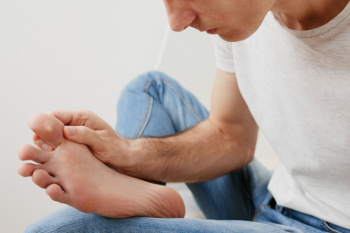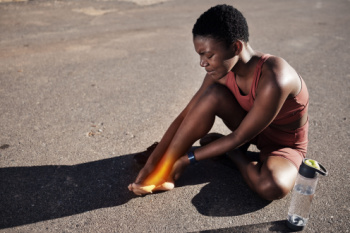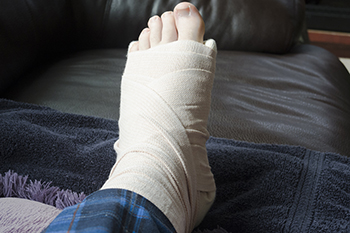
(908) 381-8160Berkeley Heights
 Plantar warts are common skin growths that appear on the soles of the feet. They are caused by exposure to the human papillomavirus, or HPV. These warts are often rough and spongy, and can be painful when pressure is applied while walking or standing. Plantar warts can be treated using a range of methods, depending on their size and severity. Salicylic acid, which gradually peels away the infected skin, may be used for mild cases. For more stubborn warts, a podiatrist may recommend cryotherapy, which uses liquid nitrogen to freeze and kill the wart tissue. Another effective method is laser treatment, where concentrated beams of light are used to destroy the wart. In some cases, minor surgical procedures might be necessary to remove the wart. Podiatrists, or foot doctors, are trained in the treatment of plantar warts. If you have plantar warts, it is suggested that you schedule an appointment with this type of doctor for effective solutions.
Plantar warts are common skin growths that appear on the soles of the feet. They are caused by exposure to the human papillomavirus, or HPV. These warts are often rough and spongy, and can be painful when pressure is applied while walking or standing. Plantar warts can be treated using a range of methods, depending on their size and severity. Salicylic acid, which gradually peels away the infected skin, may be used for mild cases. For more stubborn warts, a podiatrist may recommend cryotherapy, which uses liquid nitrogen to freeze and kill the wart tissue. Another effective method is laser treatment, where concentrated beams of light are used to destroy the wart. In some cases, minor surgical procedures might be necessary to remove the wart. Podiatrists, or foot doctors, are trained in the treatment of plantar warts. If you have plantar warts, it is suggested that you schedule an appointment with this type of doctor for effective solutions.
Plantar warts can be very uncomfortable. If you need your feet checked, contact Dr. Janet Leicht from New Jersey. Our doctor will assist you with all of your foot and ankle needs.
About Plantar Warts
Plantar warts are the result of HPV, or human papillomavirus, getting into open wounds on the feet. They are mostly found on the heels or balls of the feet.
While plantar warts are generally harmless, those experiencing excessive pain or those suffering from diabetes or a compromised immune system require immediate medical care. Plantar warts are easily diagnosed, usually through scraping off a bit of rough skin or by getting a biopsy.
Symptoms
Treatment
To help prevent developing plantar warts, avoid walking barefoot over abrasive surfaces that can cause cuts or wounds for HPV to get into. Avoiding direct contact with other warts, as well as not picking or rubbing existing warts, can help prevent the further spread of plantar warts. However, if you think you have developed plantar warts, speak to your podiatrist. He or she can diagnose the warts on your feet and recommend the appropriate treatment options.
If you have any questions please feel free to contact our office located in Berkeley Heights, NJ . We offer the newest diagnostic and treatment technologies for all your foot and ankle needs.
 There is a complex interplay of structures in the feet that provide stability, balance, and propulsion during walking and other activities. Bones, muscles, ligaments, and tendons work together in the feet to move the body biomechanically. Assessing normal foot biomechanics helps podiatrists, or foot doctors, diagnose and treat various foot issues. By using their knowledge of normal foot biomechanics, podiatrists can identify abnormalities or dysfunctions that may contribute to foot problems, such as flat feet, high arches, bunions, or plantar fasciitis. Podiatrists may analyze a patient's gait, foot structure, and range of motion. This allows them to develop personalized treatment plans that may include orthotic devices, exercises, footwear modifications, or other interventions to address underlying biomechanical issues. If you are suffering with abnormalities in gait, range of motion, or the feet in general, it is suggested that you make an appointment with a podiatrist for a personalized treatment plan.
There is a complex interplay of structures in the feet that provide stability, balance, and propulsion during walking and other activities. Bones, muscles, ligaments, and tendons work together in the feet to move the body biomechanically. Assessing normal foot biomechanics helps podiatrists, or foot doctors, diagnose and treat various foot issues. By using their knowledge of normal foot biomechanics, podiatrists can identify abnormalities or dysfunctions that may contribute to foot problems, such as flat feet, high arches, bunions, or plantar fasciitis. Podiatrists may analyze a patient's gait, foot structure, and range of motion. This allows them to develop personalized treatment plans that may include orthotic devices, exercises, footwear modifications, or other interventions to address underlying biomechanical issues. If you are suffering with abnormalities in gait, range of motion, or the feet in general, it is suggested that you make an appointment with a podiatrist for a personalized treatment plan.
If you have any concerns about your feet, contact Dr. Janet Leicht from New Jersey. Our doctor can provide the care you need to keep you pain-free and on your feet.
Biomechanics in Podiatry
Podiatric biomechanics is a particular sector of specialty podiatry with licensed practitioners who are trained to diagnose and treat conditions affecting the foot, ankle and lower leg. Biomechanics deals with the forces that act against the body, causing an interference with the biological structures. It focuses on the movement of the ankle, the foot and the forces that interact with them.
A History of Biomechanics
Modern technological improvements are based on past theories and therapeutic processes that provide a better understanding of podiatric concepts for biomechanics. Computers can provide accurate information about the forces and patterns of the feet and lower legs.
Understanding biomechanics of the feet can help improve and eliminate pain, stopping further stress to the foot.
If you have any questions please feel free to contact our office located in Berkeley Heights, NJ . We offer the newest diagnostic and treatment technologies for all your foot and ankle needs.

Foot pain can affect anyone, regardless of age or activity level, and can stem from various causes. Plantar fasciitis, the inflammation of the tissue connecting the heel bone to the toes, often results from overuse or improper foot mechanics, leading to stabbing pain in the heel. Bunions, bony bumps that form at the base of the big toe, can cause discomfort and difficulty walking due to pressure on the joint. Turf toe, an injury to the ligaments surrounding the big toe, commonly affects athletes and results from hyperextension during activities like running or jumping. Treatment for foot pain typically involves rest, stretching exercises, and wearing supportive footwear. In severe cases, custom orthotic devices or surgical intervention may be necessary. Podiatrists specialize in diagnosing and treating foot ailments, offering personalized care plans tailored to each patient's needs. If you want to alleviate existing foot pain, correct foot deformities, or prevent future injuries, it is suggested that you schedule an appointment with a podiatrist to help you restore and maintain foot health.
Foot Pain
Foot pain can be extremely painful and debilitating. If you have a foot pain, consult with Dr. Janet Leicht from New Jersey. Our doctor will assess your condition and provide you with quality foot and ankle treatment.
Causes
Foot pain is a very broad condition that could be caused by one or more ailments. The most common include:
Diagnosis
To figure out the cause of foot pain, podiatrists utilize several different methods. This can range from simple visual inspections and sensation tests to X-rays and MRI scans. Prior medical history, family medical history, and any recent physical traumatic events will all be taken into consideration for a proper diagnosis.
Treatment
Treatment depends upon the cause of the foot pain. Whether it is resting, staying off the foot, or having surgery; podiatrists have a number of treatment options available for foot pain.
If you have any questions, please feel free to contact our office located in Berkeley Heights, NJ . We offer the newest diagnostic and treatment technologies for all your foot care needs.
 Selecting the right running shoe involves considering several factors to ensure optimal support, comfort, and injury prevention. The first is your foot type, such as flat feet, high arches, or normal arches. You may also have a certain gait pattern, which is how your foot moves when you walk or run. Some people have feet that roll to the outside or inside, and certain shoes address this. Another consideration in choosing running shoes is the type of running you'll be doing. The right shoe should provide adequate cushioning to absorb impact, support tailored to your foot's arch type, and a comfortable fit for natural foot movement. Podiatrists can help you to understand all of the factors in this selection process. With their expertise in foot mechanics and conditions, podiatrists can perform a comprehensive evaluation of your feet to recommend shoes that match your needs. For example, they can conduct a gait analysis to recommend the right shoes for the way you walk. They can also identify any underlying issues that might affect your choice, such as pronation concerns or the need for custom orthotics. If you are in the market for new running shoes, it is suggested that you consult a podiatrist to find shoes that will maintain your foot health and optimize your running performance.
Selecting the right running shoe involves considering several factors to ensure optimal support, comfort, and injury prevention. The first is your foot type, such as flat feet, high arches, or normal arches. You may also have a certain gait pattern, which is how your foot moves when you walk or run. Some people have feet that roll to the outside or inside, and certain shoes address this. Another consideration in choosing running shoes is the type of running you'll be doing. The right shoe should provide adequate cushioning to absorb impact, support tailored to your foot's arch type, and a comfortable fit for natural foot movement. Podiatrists can help you to understand all of the factors in this selection process. With their expertise in foot mechanics and conditions, podiatrists can perform a comprehensive evaluation of your feet to recommend shoes that match your needs. For example, they can conduct a gait analysis to recommend the right shoes for the way you walk. They can also identify any underlying issues that might affect your choice, such as pronation concerns or the need for custom orthotics. If you are in the market for new running shoes, it is suggested that you consult a podiatrist to find shoes that will maintain your foot health and optimize your running performance.
You should always make sure your running shoes fit properly in order to avoid injury. For more information, contact Dr. Janet Leicht from New Jersey. Our doctor can provide the care you need to keep you pain-free and on your feet.
Choosing the Right Running Shoe for Your Foot Type
Improper shoe sizing can cause a myriad of problems for your feet. Shoes that don’t fit you properly can lead to muscular imbalances in your body, which can result in foot, knee, and hip injuries.
Tips for Finding the Right Running Shoe
If you have any questions please feel free to contact our our office located in Berkeley Heights, NJ . We offer the newest diagnostic and treatment technologies for all your foot and ankle needs.
 Fractures of the foot not only affect the bones but can also cause soft tissue damage to the muscles, ligaments, and skin surrounding them. These types of injuries often occur due to high-impact events like falls, sports accidents, or direct blows to the foot. The presence of soft tissue damage can significantly complicate the healing process, as it may lead to increased pain, swelling, and a prolonged recovery period. The treatment for such fractures typically involves more than just addressing the broken bone. It means the soft tissues need to be treated carefully to ensure proper healing. This might include putting the foot in a cast or boot, exercises to restore strength and flexibility, and possibly surgery to repair both the bone and soft tissues. The goal of treatment is to restore as much function as possible while minimizing the risk of long-term complications. Podiatrists can effectively treat foot fractures and soft tissue damage, and it is suggested that you promptly schedule an appointment with this type of doctor if you have endured a foot fracture.
Fractures of the foot not only affect the bones but can also cause soft tissue damage to the muscles, ligaments, and skin surrounding them. These types of injuries often occur due to high-impact events like falls, sports accidents, or direct blows to the foot. The presence of soft tissue damage can significantly complicate the healing process, as it may lead to increased pain, swelling, and a prolonged recovery period. The treatment for such fractures typically involves more than just addressing the broken bone. It means the soft tissues need to be treated carefully to ensure proper healing. This might include putting the foot in a cast or boot, exercises to restore strength and flexibility, and possibly surgery to repair both the bone and soft tissues. The goal of treatment is to restore as much function as possible while minimizing the risk of long-term complications. Podiatrists can effectively treat foot fractures and soft tissue damage, and it is suggested that you promptly schedule an appointment with this type of doctor if you have endured a foot fracture.
Foot and ankle trauma is common among athletes and the elderly. If you have concerns that you may have experienced trauma to the foot and ankle, consult with Dr. Janet Leicht from New Jersey. Our doctor will assess your condition and provide you with quality foot and ankle treatment.
Foot and ankle trauma cover a range of injuries all over the foot; common injuries include:
Symptoms
Symptoms of foot and ankle injuries vary depending on the injury, but more common ones include:
Diagnosis
To properly diagnose the exact type of injury, podiatrists will conduct a number of different tests. Some of these include sensation and visual tests, X-rays, and MRIs. Medical and family histories will also be taken into account.
Treatment
Once the injury has been diagnosed, the podiatrist can than offer the best treatment options for you. In less severe cases, rest and keeping pressure off the foot may be all that’s necessary. Orthotics, such as a specially made shoes, or immobilization devices, like splints or casts, may be deemed necessary. Finally, if the injury is severe enough, surgery may be necessary.
If you have any questions, please feel free to contact our office located in Berkeley Heights, NJ . We offer the newest diagnostic and treatment technologies for all your foot care needs.